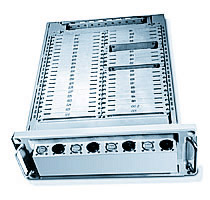A-40 Computer
Home → Articles → A-40 Computer
- A-40 airborne computer.
- Chief designers: E. G. Pronin, V. I. Shteinberg. Development engineers: V. P. Berkovich, V. I. Tuzhilin, V. I. Alekseyev, G. I. Ainshtein, N. A. Zykov, Yu. N. Maksakov, P. I. Osokin, A. S. Salman, S. M. Tyunis, N. B. Shteingard, B. I. Yurgayev.

A-40 computer
- Designing organization: Research Institute of Computer Engineering (NICEVT) of the USSR Ministry of Radio Engineering (since 1986 - Research Institute NII Argon).
- Manufacturer: Astrakhan Progress factory.
- Completion of development: 1978.
- Beginning of production: 1980.
- Termination of production: still in production.
- Field of application: automated control systems of military installations.
- Number of machines produced: over 200.
- Description: A-40 is a medium-level model of unified high-end 32-bit airborne computers based on the ES EVM architecture. It is a further development of A-30 machine. The advancements done are as follows: connecting additional I/O channels, external memory and I/O devices of ES EVM. The computer is controlled by firmware. The CPU is based on a sophisticated structure close to ES 1060 computer, which allows simultaneous execution of multiple instructions.
A-40 computer is fully compatible with Ritm-20 machine due to emulating its instructions. All non-privileged logical instructions and arithmetical commands with fixed point are emulated by hardware while privileged instructions and commands with floating point are emulated by software.
Data exchange takes place through an I/O channel integrated with a processor. It has multiplex memory located in the main memory and an exchange buffer in the channel. Control and management console including an I/O interface simulator is developed for A-40. The simulator allows debugging and testing an I/O channel and can generate channel modes unavailable when usual I/O devices are used.
Instruction set - full ES EVM-1 set, 60 Ritm-20 commands implemented by hardware, two transfer commands switching from ES mode to Ritm mode and back.

A-40 processor unit
Data types - a byte, a 16-bit word, a 32-bit double word.
Interrupt system - five classes identical to ES EVM.
Speed - 500,000 operations per second in format RX.
Performance - 140,000 operations per second with Gibson 3E mixture.
RAM - ferrite cores; capacity - 32 Kbytes; memory cycle - 2 ms; access time - 1 ms.
ROM - ferrite cores; capacity - 128 Kbytes; memory cycle - 2 ms; access time - 1 ms.
Microcode ROM - ferrite cores; capacity - 4,096 72-bit words; memory cycle - 1 ms; access time - 0,5 ms.
Number of I/O channels - 1.
I/O channel throughput - 650 Kbps in burst mode; 65 Kbps in byte-multiplex mode.
Number of external subscribers - up to 127.
- Element base: 134, 136, 130 and 133 series MSIs.
- Design: modular with three hierarchical levels - cell, unit and rack. A cell consists of two multilayer printed circuit boards electrically connected by wires or printed stubs and equipped with a 135-pin connector. The cells comprise a functionally and technically accomplished unit and are interconnected through special terminal blocks which fasten the connector plugs to the frame and provide 0- and 5 V circuit organization through a bus system. A wire wrap method is used for cell switching. The units are mechanically attached to a chassis and electrically connected by wires. The design of computer units and bodies is ingenious, with two-board cells providing higher component density. Forced cooling is used.
- Technology: ES EVM-like unified multilayer printed circuit boards manufactured by metal coating of through holes. The number of switching layers is up to 10.
- Software: custom real-time operating system, control and diagnostic utilities, auxiliary OS debugging software, test check programs.
- Specifications:
Volume - 400 q. dm.
Weight - 180 kg.
Power consumption - 800 W.
MTBF - 800 h.
- Special features: software compatibility with Ritm-20 computer due to hardware and software Ritm instruction set emulation. The first airborne computer wherein ES EVM-1 architecture concepts are fully implemented.



